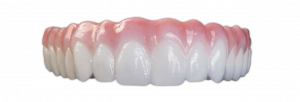 Are you a denture user or do you have severely damaged teeth that need to be extracted? Your treatment options are better now than ever!
Are you a denture user or do you have severely damaged teeth that need to be extracted? Your treatment options are better now than ever!
Dental implants have become the standard of care for replacement of missing teeth, and they have dramatically improved the lives of millions of people with dentures. However, the number one challenge for many people in need of this life-changing treatment is the cost.
Complete replacement of teeth with dental implants is certainly not an inexpensive investment. And here is why: digital diagnostic imaging, optical scans, and diagnostic photos and models begin the planning phase; extensive work by the surgeon and restorative dentist requiring hours and hours of planning, design, and treatment implementation along with the support of a team of assistants, surgical coordinators, and treatment coordinators; endless surgical and restorative components including dental implant fixtures, healing abutments, surgical kits, temporary posts, multi-unit abutments, screws, and impression materials; laboratory fabricated temporary and final restorations; eight to ten appointments to implement each phase of the treatment with each requiring the dental team and lots of time to complete; and lastly, multiple consultations, follow-up appointments, post-treatment adjustments, and all the necessary support during and long after the completion of treatment.
When it comes to full-arch dental implant treatments, you will generally find two major pricing options offered by different dentists and implant centers: global vs. à la carte fee structures. Let’s look at each one in more detail:
- The global fee structure provides patients one flat fee that covers all aspects of the treatment. This includes all diagnostics, planning, surgical, restorative, laboratory work, and materials. Some fee packages also include any necessary extractions in the same global fee. Generally, adjunctive procedures, such as bone grafting procedures and anesthesia, are considered extra and are not included in the global fee. This fee structure offers patients the benefit of knowing exactly how much the treatment costs and having the peace of mind that no surprise costs will be added later. It also does not differentiate between the number of implants and materials for the final restoration. The ease and transparency of the global fee structure has made this option more popular among many practices.
- The à la carte fee structure itemizes each procedure for the proposed treatment, including diagnostic, surgical, and restorative phases. Hence, the final fee can vary based on the number of implants, the number of tooth extractions, the design and type of restorations, and the complexity of the treatment. The final fees in the à la carte approach are generally higher than those in the global fee structure.
So, what is the actual treatment cost and which fee structures works best for you?
I’ll address the second question first. While riskier for the providers, the global fee structure is most definitely the better of the two options for patients. It offers an upfront and transparent picture of the total cost with no room for surprises later. Patients can also plan better since they know the exact cost of the treatment. Also, patients will have peace of mind, knowing no additional costs can come into picture.
The actual treatment cost can vary based on location, the type of provider (specialist or general practitioner), skills, quality of the work, and the service and overall experience delivered. Nationally, the global fees for treatment of one arch (upper or lower jaw) can range from $25,000 to $40,000, excluding bone grafting and anesthesia. Based on my experience having provided full arch treatments for many patients over the last 20 years, I suggest the following considerations when it comes to deciding where to have your treatment for the lowest cost possible:
- First, don’t make your decision based on cost only. This can be grounds for disaster because of aggressive marketing by some practices who are trying to attract patients. In fact, I would say it is safest NOT to choose the cheapest provider.
- Ask a lot of questions and then ask more. Inquire about the experience of the providers, how many full-arch implant treatments they have actually done, and what their methodology is. Do they follow digital work flow? What is the material composition of the final restoration, the type of implants and from which companies? Also try to find out the experience of previous patients by speaking with them, if possible, or at least reading their reviews.
- Consider the office, staff, and overall service. Are they responsive? Are they organized? Are they knowledgeable? Do they sound like they have done this before or does it seem like they are making things up as they go?
- Lastly, ask about payment plans. Does the practice or center offer interest-free payment plans and what are the qualifications for such third-party loans? And don’t forget to inquire about a treatment warranty and its terms. What type of support and warranty do they offer upon completion of treatment and for how long does the warranty last?
This is a considerable investment of time and money on your part, and you want to have the procedure done right the first time. So, be engaged and make sure all your questions are adequately answered. Here at our practice, we offer full-arch treatments at a flat global fee with interest-free payment plans to make it affordable for patients.
